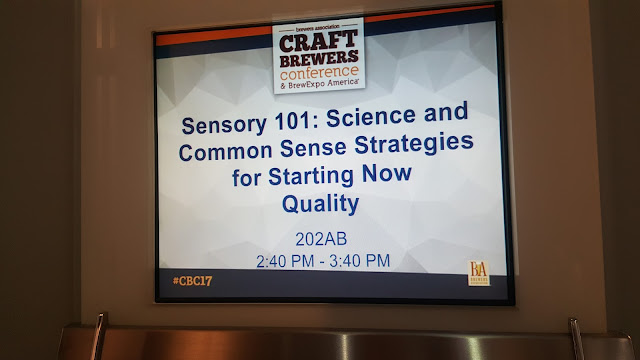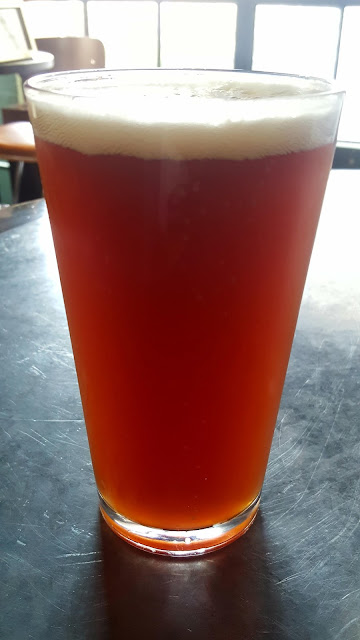The first event of the day was an educational lecture entitled "Sensory 101: Science and Common Sense Strategies for Starting Now". Led by Dr. Nicole Garneau, taste scientist and author of the Beer Flavor Map and Lindsay Barr, head sensory scientist at New Belgium Brewing Co.
Of course there's more to beer (or wine, or cigars for that matter) than just simple ingredients. And part of what we love about beer is its taste - its consistent taste -and to achieve that, brewers need to work hard. Ingredients can vary from lot to lot, fluctuations in temperature and growing conditions of the hops or malts, and human error / equipment error can impact the final product substantially. This is not to mention the challenges with managing breweries with multiple locations and production spaces. And when you run a brewery that produces a great quantity (like New Belgium, which in 2015 produced 914,000 barrels of beer - almost 30 million gallons) you need to have a set of rules and expectations for what a given beer tastes like, and how it should taste. This is called a "sensory program", and it includes the establishment of a baseline upon which testing and tasting can be performed. Today's lecture provided the how (and why) breweries have sensory quality controls and stringent management programs, and provided advice to brewers to make sure each batch of beer looks and tastes as good, as consistent, and as tasty as possible.
According to Dr. Garneau, 70% of breweries make between 1 and 1000 barrels of beer (between 31 and 31,000 gallons) and are thus classified as "developing." This is important as they are likely not big enough yet to afford their own paid tasting / testing staff, and so the point of this lecture was to introduce brewers to ways they can cheaply and easily develop a sensory program.
Building a program starts with two major tests: "Target Descriptor Generation" and "True To Target." Target Descriptor Generation, or TDG, involves the establishment of clearly-defined descriptive words used to describe a certain beer. This is usually done by having a panel of beer samplers (brewery employees, bar regulars, etc.) try a certain beer and write their tasting notes. These notes are then combined and the common words and phrases are used as the target baseline. For example, a tasting panel might conclude that a certain beer is "malty" or "sweet" or "sour" or "dry." Sure, there's going to be some variance in palates and experiences, but there will be common themes. These form that important baseline.
Then comes the next test - "True to Target." Now that a target has been established, the question must be asked - is beer X true to target? Any by these analyses, both informal (ex. "ew this tastes weird" or "wow, this is flat") to chemical and microbiological tests to determine original gravity, alcohol by volume, pH levels, etc. While baselines can shift, having an ability to say that a certain beer does not meet targets is important for mapping out a brewery's success.
So coupled together, these two tests don't really require a ton of money but can serve as a useful quality control regimen for a brewery of any size. So as you have your next sip of beer, think of the work that went in to making a consistent, even brew each time. There's a lot that goes on behind the scenes!
After the lecture I followed the crowd to the upstairs part of the Convention Center, which has been dubbed the "Coolship" area.
I Googled "coolship" because it's an odd name; turns out that a coolship is a beer term, Anglicized from the Flemish "koelschip". According to CraftBeer.com, a coolship is a wide, flat, open area for the wort to cool, much like a brownie pan sitting out on the counter. This is very apropos to this conference, as the Coolship area here is a wide, flat, open area for participants to cool off and have food and beer. Nota bene: to the right of the below picture is the other half of this cavernous space where one part of the trade show is located. Photos are not permitted due to concerns of corporate espionage, so I couldn't grab many photos.
Here's where all the beer is. There were about 8 stations sprinkled throughout this part of the hall, each giving about 3oz pours. Not super generous, but it was unlimited, so one's belly fills up quickly here. I don't have enough space to list all the ones I had, but a few that caught my eye:
This beauty is Crooked Stave Artisan Beer Project's "Colorado Wild Sage", a 7.2% ABV Brettanomyces saison made with white sage and lemongrass. This was probably one of my favorites of the whole conference - armed with a peculiar, herbal aroma, it's light and earthy with the majority of the flavors hitting you on the finish and aftertaste. The herbs are big - owing to the lemongrass and sage - and there's a bit of a hops, but mostly soft and earthy. Really great, I immediately went back for a second one after trying this.
Next up is Dayton, OH-based Warped Wing's "Gamma Bomb", a 7.2% IPA that's perfect for the hopheads out there: there's a wave of resiny, piney hops and a burst of bitter, tangy flavors on the finish. It's a bit too acidic for me, but definitely good for the IPA lovers.
There was quite the line for this beer, so it must be good: Lawson's Finest Liquids "Sip of Sunshine", a 8.00% India pale ale that is very true to its name - it's bright, fresh, and bursting with orange juice flavors. There's a little hop bite in there to keep it interesting, but mostly lush fruit flavors and a nice fizzy texture. I could drink this all day long. Also, can we appreciate the cool name of the brewery?
Sometimes the best stuff is in unassuming packaging. This beer, served out of a repurposed Coleman cooler, was certainly intriguing - it's a 5.5% ABV dark berry sour from Wooden Robot Brewing Co. Made with boysenberries, this farmhouse-style ale is super sour, in a puckery kind of way. There's a pleasant astringency to it that adds a cool texture, although I don't know if I'd spring for a full pint. Sometimes off-the-beaten-path beers like this are best enjoyed in small doses.
And, for the last one of the series, here's Olde Hickory's "Ruby" lager, a dry and clean 4.0% ABV lager that's a refreshing and slightly sour, but not particularly unusual. But tasty nonetheless, and super light in alcohol, so makes this a nice session beer. The slight sourness is a nice touch.
Wandering around the venue I saw this, which was pretty cool. I of course added a shameless plug for the blog in the "What Brought You Here" section and, drawing off my professional career, added a few points to one of the other panels, "Tips for Engaging Your Legislators." Even beer needs lobbyists!
Later that night, I headed to Bar Deco in Gallery Place for Port City and Bear Republic's launch party of the "Amaro-Aged Metro Red", which Port City's usual West-Coast red ale "Metro Red" but aged in Don Cicco & Figli lemon-washed Amaro delle Sirene barrels. My fondness for red ales (and fondness for barrel-aged ales) made this particularly attractive.
When poured, it generates a thin white head with not a lot of aroma.
While it's only 6.5% ABV, it's heavier than I expected, super malty, with the sweetness of the barrel aging replacing the usual pine-needle notes. I can see the barrel aging contributing to the gravity, too, since it was pretty heavy and cloudy with not a lot of carbonation. It's hard to pick up any aroma in a bar, but certainly the flavor came through. Overall a solid beer that's a nice representation of a barrel-aged red. It was $9 a pint here at the bar, so expensive, but it's what you gotta pay for special beer!
Also, for the life of me, I CANNOT get the above formatting work right.


















No comments:
Post a Comment